Abstract
A radioimmunoassay has been developed that permits reliable measurements of plasma arginine vasopressin (AVP) at concentrations as low as 0.5 pg/ml in sample volumes of 1 ml or less. Nonhormonal immunoreactivity associated with the plasma proteins is eliminated by acetone precipitation before assay, leaving unaltered a component that is immunologically and chromatographically indistinguishable from standard AVP. Storage of plasma results in a decline in AVP concentration and, thus, must be carefully regulated. The plasma AVP values obtained by our method approximate the anticipated levels and vary in accordance with physiologic expections. In recumbent normal subjects, plasma AVP ranged from (mean ±SD) 5.4±3.4 pg/ml after fluid deprivation to 1.4±0.8 pg/ml after water loading, and correlated significantly with both plasma osmolality (r=0.52; P<0.001) and urine osmolality (r=0.77; P<0.001). After fluid restriction, plasma AVP was uniformly normal relative to plasma osmolality in patients with nephrogenic diabetes insipidus and primary polydipsia but was distinctly subnormal in all patients with pituitary diabetes insipidus. The infusion of physiologic amounts of posterior pituitary extract caused a dose-related rise in plasma vasopressin that afterwards declined at the expected rate (t½=22.5±4 min). We conclude that, when used appropriately, our radioimmunoassay method provides a useful way of assessing AVP function in man.
Full text
PDF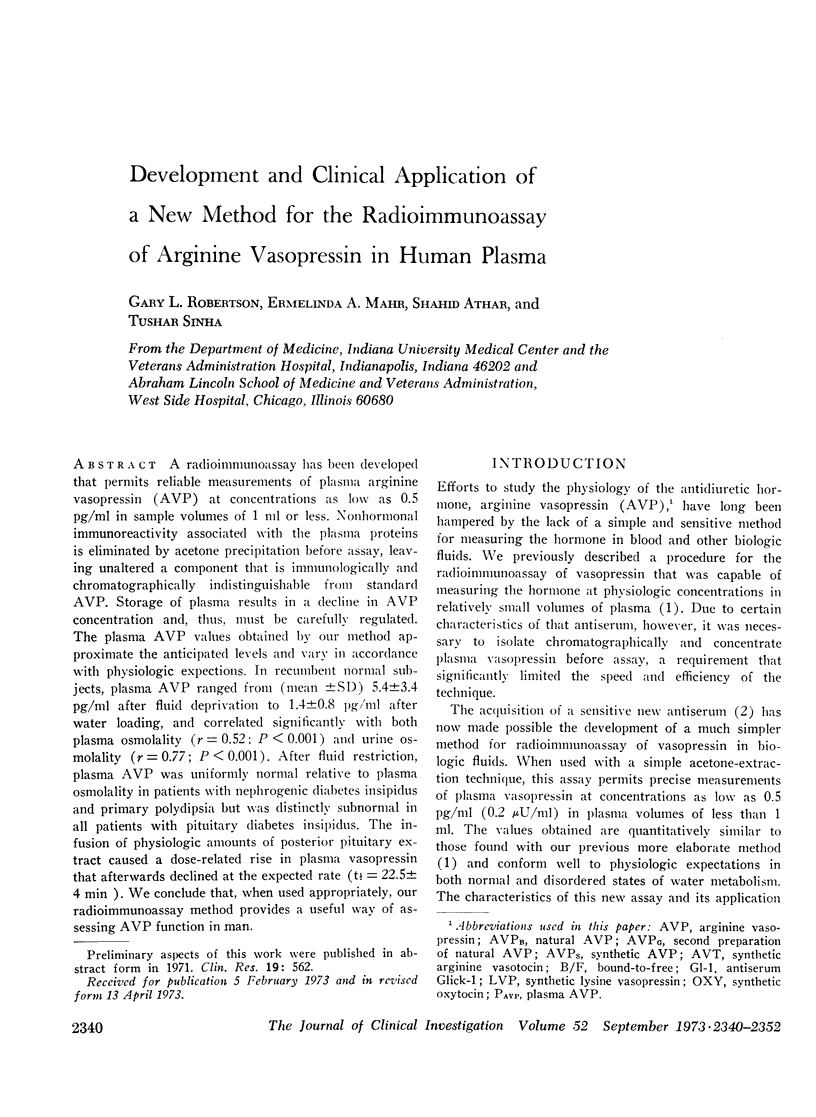

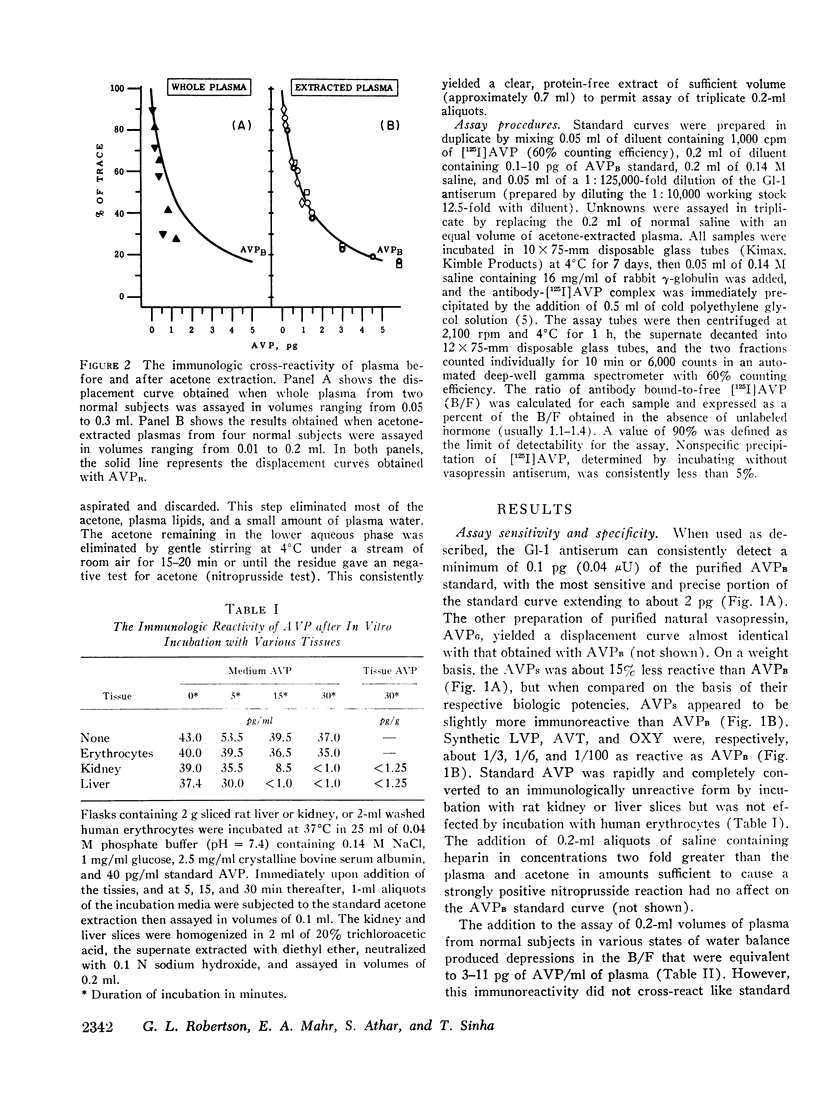

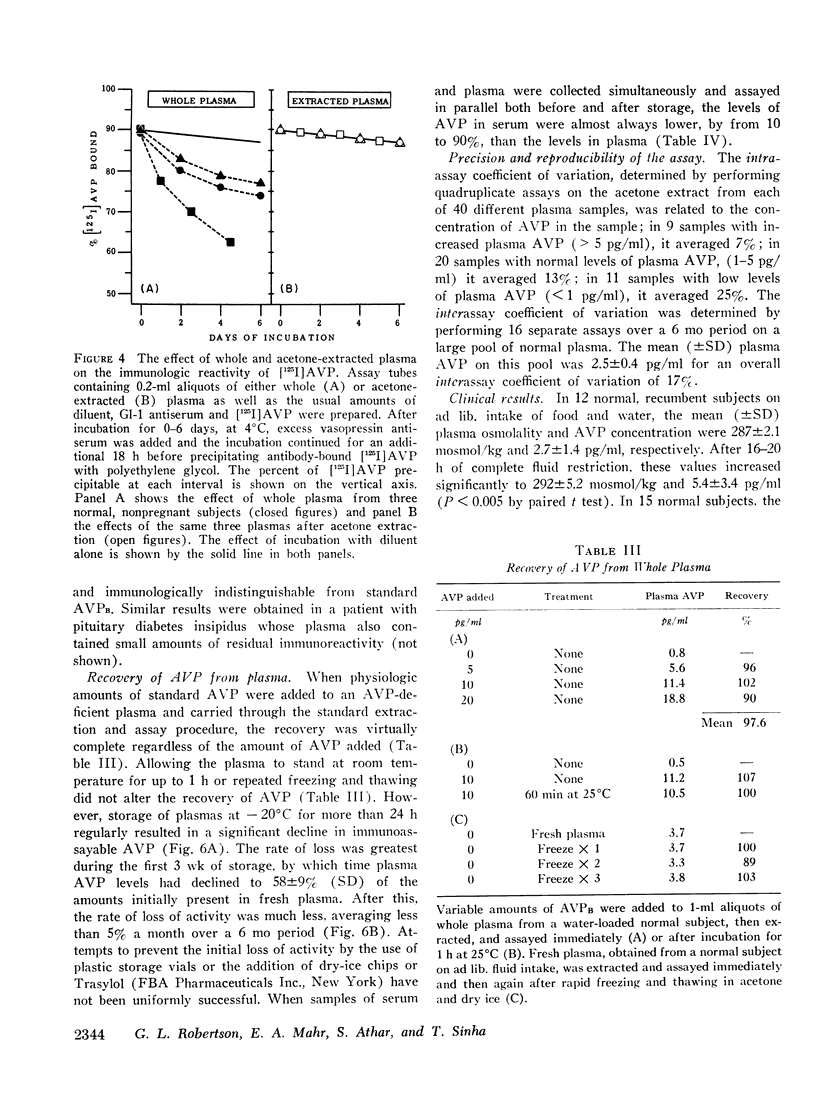



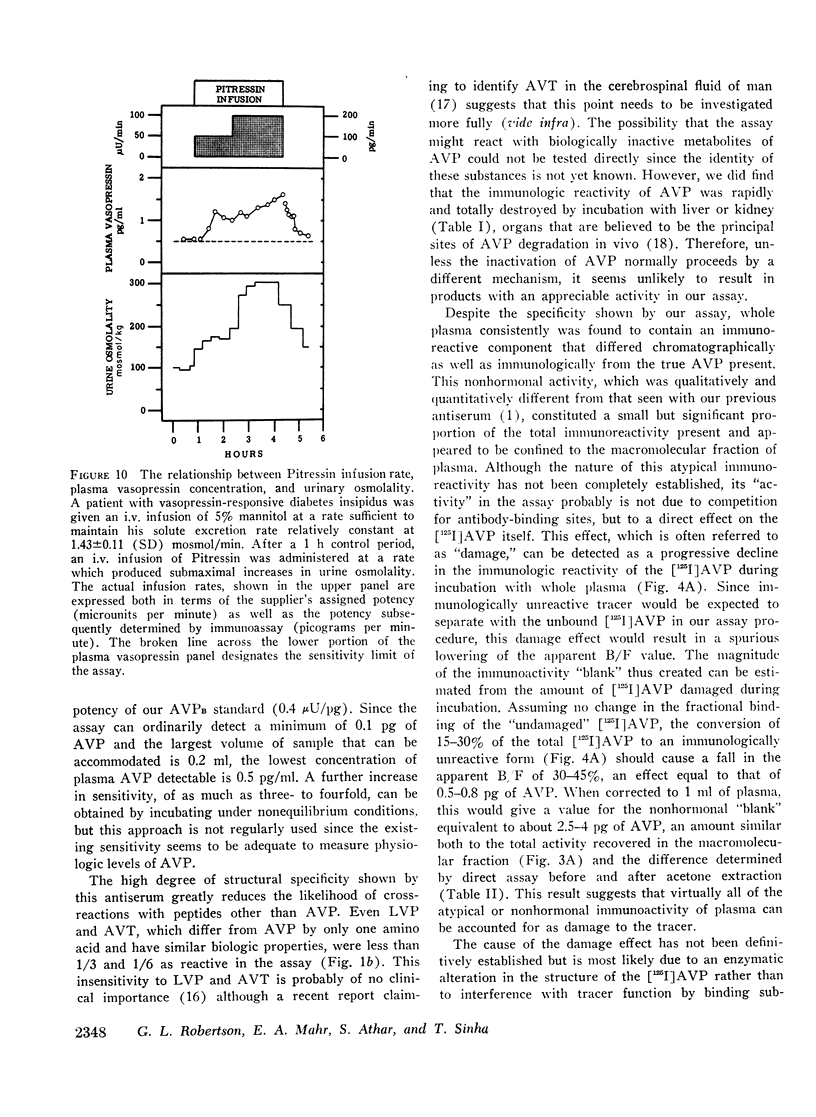



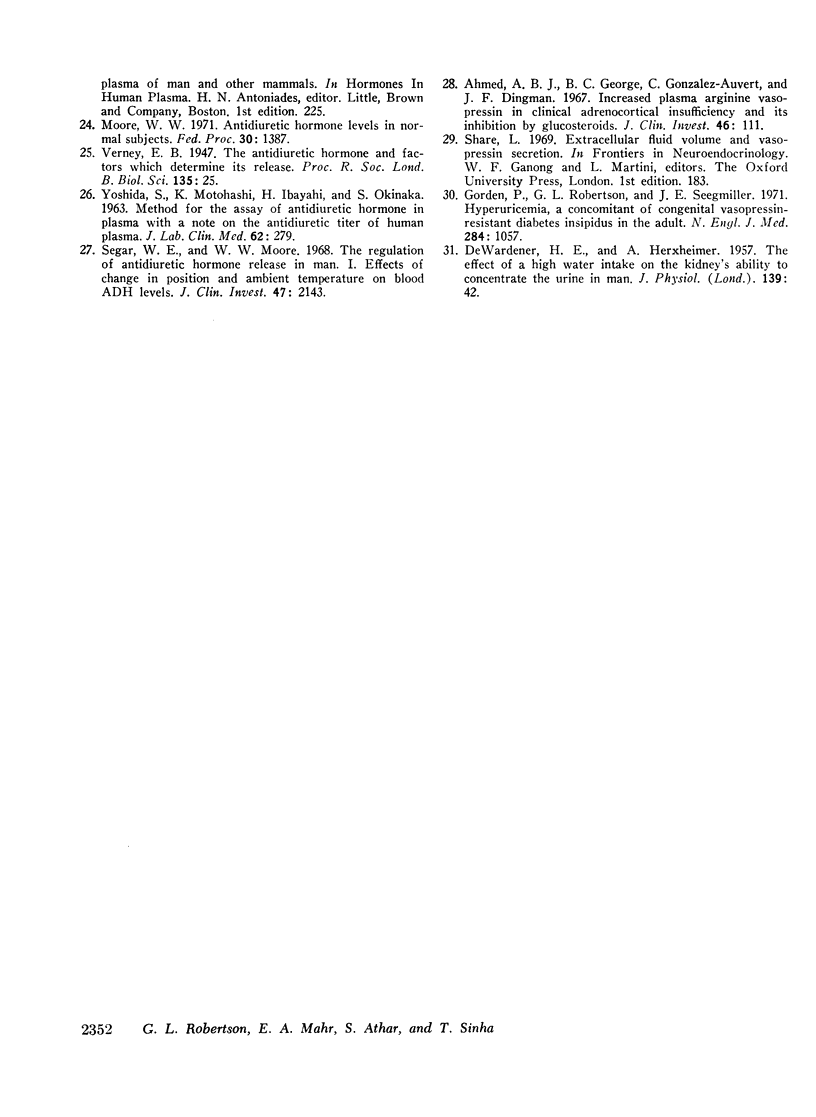
Selected References
These references are in PubMed. This may not be the complete list of references from this article.
- ACHER R., LIGHT A., DU VIGNEAUD V. Purification of oxytocin and vasopressin by way of a protein complex. J Biol Chem. 1958 Jul;233(1):116–120. [PubMed] [Google Scholar]
- Ahmed A. B., George B. C., Gonzalez-Auvert C., Dingman J. F. Increased plasma arginine vasopressin in clinical adrenocortical insufficeincy and its inhibition by glucosteroids. J Clin Invest. 1967 Jan;46(1):111–123. doi: 10.1172/JCI105504. [DOI] [PMC free article] [PubMed] [Google Scholar]
- Beardwell C. G. Radioimmunoassay of arginine vasopressin in human plasma. J Clin Endocrinol Metab. 1971 Aug;33(2):254–260. doi: 10.1210/jcem-33-2-254. [DOI] [PubMed] [Google Scholar]
- Breslow E., Walter R. Binding properties of bovine neurophysins I and II: an equilibrium dialysis study. Mol Pharmacol. 1972 Jan;8(1):75–81. [PubMed] [Google Scholar]
- CZACZKES J. W., KLEEMAN C. R., KOENIG M. PHYSIOLOGIC STUDIES OF ANTIDIURETIC HORMONE BY ITS DIRECT MEASUREMENT IN HUMAN PLASMA. J Clin Invest. 1964 Aug;43:1625–1640. doi: 10.1172/JCI105038. [DOI] [PMC free article] [PubMed] [Google Scholar]
- Desbuquois B., Aurbach G. D. Use of polyethylene glycol to separate free and antibody-bound peptide hormones in radioimmunoassays. J Clin Endocrinol Metab. 1971 Nov;33(5):732–738. doi: 10.1210/jcem-33-5-732. [DOI] [PubMed] [Google Scholar]
- Edwards C. R., Chard T., Kitau M. J., Forsling M. L. The development of a radioimmunoassay and a plasma extraction method for vasopressin. J Endocrinol. 1970 Sep;48(1):xi–xii. [PubMed] [Google Scholar]
- Gorden P., Robertson G. L., Seegmiller J. E. Hyperuricemia, a concomitant of congenital vasopressin-resistant diabetes insipidus in the adult. N Engl J Med. 1971 May 13;284(19):1057–1060. doi: 10.1056/NEJM197105132841903. [DOI] [PubMed] [Google Scholar]
- Johnston C. I. Radioimmunoassay for plasma antidiuretic hormone. J Endocrinol. 1972 Jan;52(1):69–78. doi: 10.1677/joe.0.0520069. [DOI] [PubMed] [Google Scholar]
- Lauson H. D. Metabolism of antidiuretic hormones. Am J Med. 1967 May;42(5):713–744. doi: 10.1016/0002-9343(67)90091-5. [DOI] [PubMed] [Google Scholar]
- Menard J., Milliez P. Système radio-immunologique pour le dosage de l'hormone antidiurétique. C R Acad Sci Hebd Seances Acad Sci D. 1970 Feb 16;270(7):1053–1056. [PubMed] [Google Scholar]
- Miller M., Moses A. M. Radioimmunoassay of vasopressin with a comparison of immunological and biological activity in the rat posterior pituitary. Endocrinology. 1969 Mar;84(3):557–562. doi: 10.1210/endo-84-3-557. [DOI] [PubMed] [Google Scholar]
- Moore W. W. Antidiuretic hormone levels in normal subjects. Fed Proc. 1971 Jul-Aug;30(4):1387–1394. [PubMed] [Google Scholar]
- Oyama S. N., Kagan A., Glick S. M. Radioimmunoassay of vasopressin: application to unextracted human urine. J Clin Endocrinol Metab. 1971 Nov;33(5):739–744. doi: 10.1210/jcem-33-5-739. [DOI] [PubMed] [Google Scholar]
- Pavels S. Tentative identification of arginine vasotocin in human cerebrospinal fluid. J Clin Endocrinol Metab. 1970 Oct;31(4):369–371. doi: 10.1210/jcem-31-4-369. [DOI] [PubMed] [Google Scholar]
- Permutt M. A., Parker C. W., Utiger R. D. Immunochemical studies with lysine vasopressin. Endocrinology. 1966 Apr;78(4):809–814. doi: 10.1210/endo-78-4-809. [DOI] [PubMed] [Google Scholar]
- Reis E., Canterbury J. M. A radioimmunoassay for parathyroid hormone in man. Proc Soc Exp Biol Med. 1968 Jun;128(2):501–504. doi: 10.3181/00379727-128-33050. [DOI] [PubMed] [Google Scholar]
- Robertson G. L., Klein L. A., Roth J., Gorden P. Immunoassay of plasma vasopressin in man. Proc Natl Acad Sci U S A. 1970 Aug;66(4):1298–1305. doi: 10.1073/pnas.66.4.1298. [DOI] [PMC free article] [PubMed] [Google Scholar]
- Robinson A. G., Zimmerman E. A., Frantz A. G. Physiologic investigation of posterior pituitary binding proteins neurophysin I and neurophysin II. Metabolism. 1971 Dec;20(12):1148–1155. doi: 10.1016/0026-0495(71)90040-0. [DOI] [PubMed] [Google Scholar]
- Rogge J. D., Moore W. W., Segar W. E., Fasola A. F. Effect of +Gz and +Gx acceleration on peripheral venous ADH levels in humans. J Appl Physiol. 1967 Dec;23(6):870–874. doi: 10.1152/jappl.1967.23.6.870. [DOI] [PubMed] [Google Scholar]
- Roth J., Glick S. M., Klein L. A., Petersen M. J. Specific antibody to vasopressin in man. J Clin Endocrinol Metab. 1966 Jun;26(6):671–675. doi: 10.1210/jcem-26-6-671. [DOI] [PubMed] [Google Scholar]
- Sawyer W. H. Evolution of antidiuretic hormones and their functions. Am J Med. 1967 May;42(5):678–686. doi: 10.1016/0002-9343(67)90088-5. [DOI] [PubMed] [Google Scholar]
- Segar W. E., Moore W. W. The regulation of antidiuretic hormone release in man: I. Effects of change in position and ambient temperature on blood ADH levels. J Clin Invest. 1968 Sep;47(9):2143–2151. doi: 10.1172/JCI105900. [DOI] [PMC free article] [PubMed] [Google Scholar]
- Wu W. H., Rockey J. H. Antivasopressin antibody. Characterization of high-affinity rabbit antibody with limited association constant heterogeneity. Biochemistry. 1969 Jul;8(7):2719–2728. doi: 10.1021/bi00835a005. [DOI] [PubMed] [Google Scholar]
- YOSHIDA S., MOTOHASHI K., IBAYASHI H., OKINAKA S. METHOD FOR THE ASSAY OF ANTIDIURETIC HORMONE IN PLASMA WITH A NOTE ON THE ANTIDIURETIC TITER OF HUMAN PLASMA. J Lab Clin Med. 1963 Aug;62:279–285. [PubMed] [Google Scholar]


